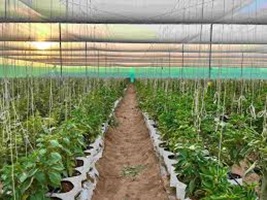Capsicum or bell pepper is a widely used vegetable in India. It is known for its texture and bright hues. This crop is highly profitable for farmers due to its widespread market demand. It is versatile and can be used in nearly any recipe.
Capsicum farming takes place in many areas of India and involves both large-scale commercial production and small-scale local production. The vegetable prefers light, well-drained soil. Moreover, it thrives in a warm climate, which is prevalent in many regions of the country.
Capsicum plants are not difficult to grow and are tender, so many farmers can produce them to meet market demands. However, they require appropriate management, such as adequate water and nutrients, to support the crops’ development. When one uses appropriate methods, capsicum farming can be both sustainable and fun.
Let’s get into the process of capsicum farming in India.
Varieties of Capsicum in India
In India, various types of capsicum (bell pepper) are cultivated, each tailored to specific climates and market preferences. Here are a few well-known varieties.
| Capsicum Types in India | |||
| California Wonder | Arka Mohini | Kashmir Delight | Green Bell Pepper |
| Yolo Wonder | Indra | Red Bell Pepper | Yellow Bell Pepper |
5 Leading Capsicum-Producing States in India
India has several states known for their significant production of capsicum. Here are the country’s main capsicum-producing states.
- West Bengal
- Karnataka
- Haryana
- Jharkhand
- Himachal Pradesh
7 Health Benefits of Capsicum
As we already know, capsicum is rich in various nutrients that our body needs. Below are the health benefits of this vegetable.
- Works as an antioxidant
- Have anti-fungal properties
- Helps in weight loss
- Can relieve pain
- Prevents cancer
- Good for eye health
- Prevents anaemia
Stages of Capsicum Cultivation
There are many vital steps in cultivating capsicum, such as weather conditions, soil preparation, planting, watering, harvesting, etc. If you are willing to cultivate capsicum, you can read about these processes in detail below.
1. Weather Requirements
Capsicum plants require warm conditions for growth, and the optimum temperature for its growth is 20°C to 30°C. They need direct sunlight conditions for 6-8 hours for efficient sunlight absorption and plant growth. Although they are inconsequential to development, temperature stress or frost can limit growth and yield.
2. Soil Preparation
Capsicum grows well in fertile, sandy, and loamy soils with a pH of 6. 0 and 6. 8. Growers should mix the compost or well-rotted manure in the soil to improve its quality. A tractor such as the Solis 6524 will be very useful in tasks like soil preparation. Through effective ploughing, this tractor is very efficient in tilling soil to a depth of 20-30 cm. Consequently, it enhances soil aeration and weed removal.
3. Plantation
Capsicum can be propagated directly from seeds or from seedlings that may have been planted before. Seeds should be sown indoors or in a seedbed 8 – 10 weeks before the last expected frost. Transplant the seedlings when they are at a 6-8 week stage when they have developed a few leaves. Space the plants 18-24 inches apart since they need good air circulation and space to spread out.
4. Irrigation
Capsicum needs frequent irrigation; however, one should avoid the water-logged conditions in the soil. Drip irrigation is perfect for this because it averts water waste and provides water at the root of the plant. This results in a lower chance of developing fungal diseases. However, during dry seasons or even without rain, growers should water the plants but should not water them too much.
5. Pest and Disease Control
Some of the most prevalent pests that pose a threat to capsicum include aphids, whiteflies, and spider mites. Some of the diseases that affect the crop are bacterial leaf spot, powdery mildew, blossom end rot, etc.
Monitoring and biological control are key techniques in Integrated Pest Management (IPM). Additionally, applying suitable insecticides or fungicides helps address these problems. Proper hygiene, proper sanitation measures, and periodic inspection also assist in early identification and management.
6. Harvesting
Capsicum is usually ready for harvest when the fruits are fully ripe. Moreover, they should have developed their recommended colour, which can be green, red, yellow, or orange, depending on the breed.
For the plant’s benefit, harvesting is done by hand rather than using mechanical means. When fruits are harvested frequently, the plant produces more fruits, and the yields are likely to be higher.
7. Post-Harvesting Processes
When capsicums are ready to harvest, growers should carefully handle the fruits so that they do not develop bruises. The vegetables should then be sorted by size and quality and graded into different categories.
For effective post-harvest processes, an efficient tractor such as the Farmtrac 45 can be useful, especially during transportation. The Farmtrac 45 tractor price starts from Rs. 6.90 lakh and goes up to 7.17 Lakh. Cleaning, cooling, and storing are critical requirements for ensuring that they remain fresh before farmers distribute them to the market.
Conclusion
Capsicum cultivation holds immense potential for profit for farmers in India. This vegetable is not very difficult to grow and is in high demand in the market. Proper weather, soil preparation, irrigation management, and control of pests and diseases make the crops healthy and productive. Careful harvesting and post-harvest handling can make capsicum a profitable crop, leading to successful farming and meeting consumer demand.


